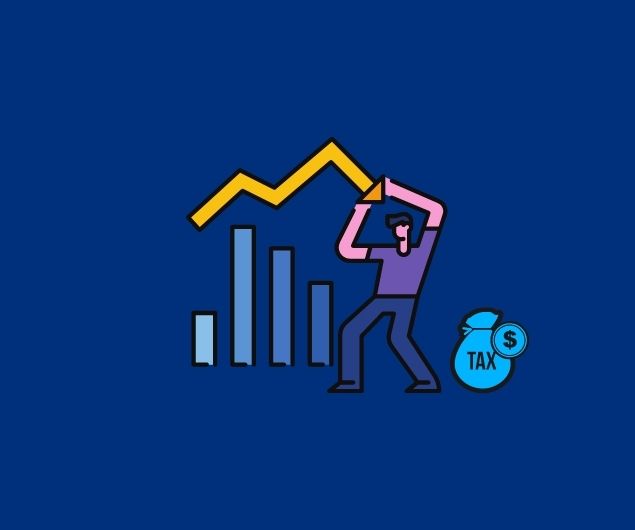This week we will be talking about Tax Savings with Losses (yes, I’m talking about Capital Loss).
Lately, we have seen headlines such as…
“Stock markets sell off as inflation fears settle in.”
“Peak Panic – Crypto Market Teeters After Huge Bitcoin, Ethereum, …. Price Crash”
“Housing Bubble Getting Ready to Pop: Mortgage Applications Plunge…”
“Saskatoon real estate company collapse leaves millions unaccounted for…”
“Homebuyers set to lose unprotected deposits of up to $150K after GTA developer refused license”
It seems a bit scary in the investment world these days. If you incurred a loss in the recent market downturn, this article is for you.
Yes, losing money sucks. However, by reporting your loss on your income tax return, you can apply this loss against your income to offset some of the tax payable in the past or in the future.
So…how does it work? You can watch my video on this here and continue reading below.
How Can You Get Tax Savings with Losses?
When it comes down to losses, we first need to get a better understanding of the type of losses available, as different tax rules apply to different types of losses. Just because we can recoup some of our loss through tax benefit, it does not mean that you don’t have a true after tax cost. Lastly, you may have thought that you incurred a bunch of losses when the stock market crashes, but in reality, there’s a difference between realized and unrealized loss.
Next week, we’ll dive deeper into how these principles apply to different types of losses, including crypto loss, real estate loss, private lending loss and stock loss.
Let’s start with the different types of losses. Generally speaking, there are two different types of losses when it comes down to investment.
1. Capital Loss
Most of us know that capital gain is 50% taxable. If you make $100,000 capital gain, only 50% of it is taxable. So only $50,000 is added to your income and you get taxed on the $50,000 only. Even at the highest marginal tax rate in Ontario 53.5%, you are only paying $26,750 tax ($50K x 53.5%).
On the flip side, when you incur capital losses, the capital losses can be offset against capital gains only. Capital losses cannot be applied against any other source of income.
Because capital gains are only 50% taxable, capital losses are also 50% deductible.
It’s worthwhile mentioning that currently, the capital gain inclusion rate is 50%. At some point in time, it was 75%. Capital losses incurred in those years also had the same inclusion rate of 75%.
You can apply your capital loss against capital gain incurred in the last 3 taxation years, if you don’t have any capital gains incurred in the current year. You can also carryforward the unused capital loss to future years indefinitely.
Capital losses created from one type of investment can be used to offset against capital gain earned from another type of investment. As an example, your crypto losses can be used to offset against the capital gain you’ve made from selling your long-term rental.
2. Business Loss
When you make business income, 100% of the income is taxable. If you make $100K, the entire $100K is subject to tax. At the highest marginal tax rate in Ontario, you are liable to pay $53,500 in taxes.
Investments can be considered business as well. This is the case for land developers, builders, people who flip properties, etc. If you are day trading stocks and cryptos, you may also be considered trading these instruments as a business. Profit you make from these investments can be considered 100% taxable.
Therefore, business loss incurred by these investments would also be considered 100% deductible.
If you lose money from a flip or from trading stocks and cryptos, 100% of the losses can be used to offset against other business income.
If you own your trading accounts or your flips in your personal name, you may even be able to use the business loss to offset against other sources of income, such as employment income, RRSP income, interest income, etc. Dollar for dollar. 100% deductible.
If you have excess unused business losses, they can be carried back 3 years to offset against prior year income. They can also be carried forward for 20 years into the future.
As a taxpayer, the bias is to report all gain as capital gain and all losses as business losses. But CRA and prior court cases have established a set of criteria to help taxpayers to decide if a transaction is considered business or capital.
Criteria determining a loss is Capital Loss vs. Business Loss
This all goes back to a bunch of criteria to decide whether you’re operating the transactions as a business or you’re doing long-term investment.
Generally speaking, CRA looks at the following criteria:
- Frequency of transactions – how often you transact on the underlying asset? Is there a pattern of behavior? Or is it a one off? If you trade stock and crypto on a daily basis, it is more likely that CRA considers your trading activities as a business transaction.
- Period of ownership – how long have you owned the underlying asset? The longer you own the underlying asset, the more likely CRA considers the transaction on a capital account. If you own a rental property for years and report rental income during the period of ownership, it is more likely that the profit you make from sale of the property as capital gain and the loss as capital loss.
- How knowledgeable are you in the market? If you study the market closely and have intensive knowledge, it is more likely that your transaction is considered a business. After all, if you treat investing as a business, you would want to learn everything about your business.
- Does the transaction form a part of your regular business? If you are a plumber and you are trading stock, stock trading has nothing to do with your regular business. It is less likely CRA would consider your stock trading as a business. Losses created would then be more likely considered capital loss.
- Time spent – how much time did you spend studying the market and finding deals? If you spent a lot of time studying crypto and you lost money on it, it’s more likely that you can argue you are trading crypto as a business. Losses incurred are more likely to be considered as business losses.
- Financing – are you borrowing money to purchase and trade the underlying investment? In the case of a stock, are you primarily using margin to finance the purchase of the stock? In the case of a real estate property, are you using short-term financing such as a one year fixed term mortgage for a flip or are you using a 5 year term mortgage? This helps CRA determine your overall intention of the transaction. Obviously, if your financing is short-term in nature, it’s more likely that your transaction is on the business side and 100% of the losses are tax deductible.
- Advertising – how much effort are you putting in to make it known to the public that you’re trying to find deals? Some people make it well known to others that they are in the market to purchase cryptos offline, without paying the expensive transaction fees. This can be an indication that you’re operating a business to trade crypto.
- In the case of shares, are they speculative in nature? Do the shares pay dividends? In the case of properties – do these properties generate rent or any other type of income? If the underlying instruments are speculative in nature, such as the case of trading GME stock through its short squeeze last year, the transaction is more likely to be considered on the business side, rather than capital. Losses incurred are then 100% deductible.
- Taxpayer’s intention – if your intention is to do a one off transaction that allows you to generate some quick profit, such as in the case of using insider information not available to the public to realize a quick profit, the profit you make is still considered on your income account. One off transaction alone does not automatically mean that the loss you incur is NOT a business transaction. It all goes back to your original intention. Your original intention is not simply what you say you intend to do, but also based on all evidence and facts existing at the time the transaction occurs.
CRA uses ALL of the above factors to come to a conclusion. It’s confusing. As taxpayers, you’re the one that’s responsible for putting all of the arguments together to support your position.
Make sure you document and keep all evidence to support your filing position.
As a taxpayer, the bias is to report all gain as capital gain and all losses as business losses. You can’t flip flop from reporting the profit you make as capital gain and then reporting the losses you incur as business loss differently every year.
A word of caution… Losses occurring inside RRSP/TFSA or any registered account are not tax deductible. If you’ve incurred losses in your RRSP, that means you have less money to withdraw from your RRSP, hence you pay less tax on withdrawal (as less money is available). If you incur losses in your TFSA, similarly, less money is available for you to withdraw and you have less contribution room available for you to recontribute.
Understanding the REAL amount of Loss
True loss is the loss that you have incurred after taking into account the tax benefit from applying your loss against your income or capital gain.
Let’s use an example to explain – say you lose $50,000 on investing in the UST stablecoin. And you typically hold crypto and stablecoin as long-term investments. So your loss is considered capital loss.
Capital loss is only 50% deductible, so only $25K of taxable loss is offset against your taxable capital gain. If your marginal tax rate is 50%, you could potentially save as much $12,500 taxes against future taxable capital gain.
Your true loss from the transaction is $50,000 – $12,500 = $37,500.
Yes, on paper, you lost $50,000. In reality, after taking into account the potential tax saving of $12,500, you truly only lost $37,500.
Realized vs. Unrealized Losses
You might think that you have a lot of losses in your stock portfolio.. But generally speaking, these losses have to be “realized” before the CRA recognizes them as true losses.
Depending on the asset type that you have the losses on, some are as simple as selling the stock in the open market, and realize the losses.
Some can be quite complicated. If you lose money in doing private lending, it can be quite complicated, depending on what you do with the underlying property.
You might have a large portfolio of crypto assets as long-term capital investments, but if you don’t realize the loss, no unrealized losses can be offset against any of the profit you make.
The Canadian Income Tax Act also has a special rule called Superficial loss. If you repurchase the same stock within 30 days after you realize the loss, the initial loss is considered superficial loss and you are not eligible to claim it.
If you’re operating a business of trading stocks or cryptos which are treated as inventory, if the value has come down, you may be eligible to offset the unrealized loss immediately against your income.
Now that we have talked all about Capital Loss, Business Loss and understanding the real amount of loss, make sure you stay notified for my next blog post. In our next blog post, we will cover how these losses are applied to different types of assets.
Until next time, stay safe in the choppy market.
Cherry Chan, CPA, CA
Your Real Estate Accountant





